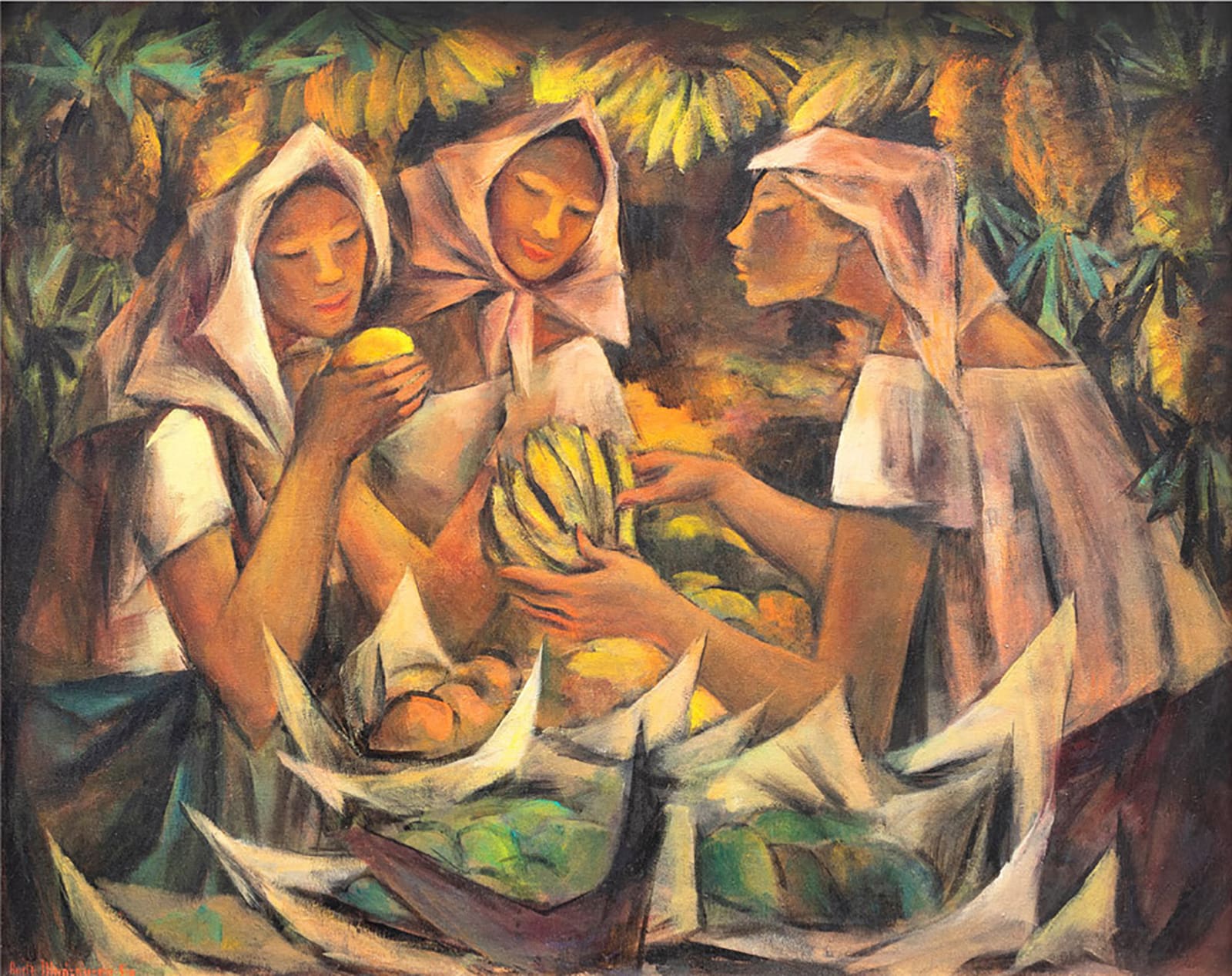“Fruit Market” by Anita Magsaysay-Ho | courtesy of León Gallery
The yearly fundraiser has already sent 41 Filipino artists on grants abroad.
There are many exceptional pieces to be auctioned off for the fundraising event at Leon Gallery on February 18—from Filipino masters like Felix R. Hidalgo to modern icons like H.R. Ocampo and Jose Joya. Many of these artworks come from the collection of esteemed patrons who themselves are influential to Philippine culture and history, such as the pioneering feminist Senator Leticia Ramos Shahani, billionaire philanthropist Loida Nicolas-Lewis, construction magnate Alice Eduardo, and other distinguished collectors who wish to remain anonymous. Browsing through the catalog of predominantly male artists, the pieces from female artists stand out and seem to tell a story on their own.
Here are three headlining artworks that have been made by women, collected and enjoyed by women, and are now being put to auction for the benefit of the Asian Cultural Council, who have been awarding study grants to Filipino artists and cultural workers since 2015.

“Fruit Market” by Anita Magsaysay-Ho (1957)
The only female painter of the Thirteen Moderns, Magsaysay-Ho’s post-Cubist paintings celebrated Filipino market life and the quiet dignity of the women who sold fruit, fish, and flowers, who worked in the fields and toiled in the kitchens. This painting uncannily mirrors a LIFE magazine photograph taken, also in 1957, of Betty Anderson, wife of Frank Anderson who owned Basilan Lumber in Zamboanga and whose collection this painting comes from. The magazine featured the American couple’s life on the island, with Betty among giant clam shells or buying native fruits at the market, Frank at a cockfight or the lumberyard, or the couple hosting a genteel garden party for other Americans. The Andersons likely acquired the painting—for P400.00—at the Philippine Art Gallery where Magsaysay-Ho held her third solo exhibition at the end of the year. It’s not a stretch to imagine the affinity Betty would have felt for the painting and how it would always remind her of those years she spent on an island in the southernmost part of the Philippines.

“Poppies and Daisies” by Betsy Westendorp (1983)
The Spanish-born Westendorp, a significant figure in the annals of Philippine art, became a “Filipino” artist when she first married the Spanish-Filipino Tony Brias, who initially did not want her to paint. She became a portraitist of society’s elite, painting Spanish royals and Philippine presidents, but is most beloved for her floral paintings captured in their ephemeral splendor. Flowers were not a common subject among the major Filipino artists of the time, and it was in this space where Betsy bloomed. “Poppies and Daisies” was acquired directly by the journalist and editor Letty Jimenez-Magsanoc, a key figure in the anti-Marcos movements of the 1980s who co-founded the Philippine Daily Inquirer. Perhaps the six-foot-long painting, with its small delicate flowers dancing among blades of grass, was a calm oasis LJM rested her eyes on after a hard day. Maybe, having been painted in 1983, it came to represent the monumental events of that year— the poppies abloom like drops of blood, the flower also known worldwide as a symbol of remembrance.

“Composition Red” by Nena Saguil (1959)
Nena Saguil, a classmate of Anita Magsaysay-Ho at the UP School of Fine Arts, was part of the modernist Neo-Realist group of Filipino painters. She would veer into abstraction and became a pioneer in that field, her art reflecting her interest in mysticism and the cosmos, visualized most notably in her dot paintings. Somewhat of a recluse, she spent the last 40 years of her life in Paris. “Composition Red,” made in Paris a few years after moving to France to study Abstract Non-Objective Art, is considered a prime example of Saguil’s bold form of abstraction. Using impasto, the piece appears to move viscously. Olivia Yao, a former banker and publisher of the book Art After War: 1948-1969, is a collector of the avant-garde. She once described her collection as “not safe, extreme, and adventurous.” She has also said that collecting art is an evolving process and should not remain stagnant. In letting go of this painting, Yao is passing along its primal energies to whoever gets swept up in its flow next.
